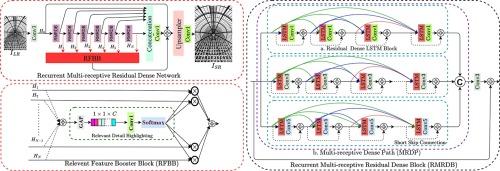RMRDN:用于图像超分辨率的递归多接受残差密集网络
IF 3
3区 工程技术
Q2 ENGINEERING, ELECTRICAL & ELECTRONIC
引用次数: 0
摘要
从低分辨率图像中重建精细纹理和结构仍然是超分辨率(SR)的核心挑战。现有的基于cnn的SR模型往往存在接收域有限、远程依赖建模弱、分层特征利用不足等问题。为了解决这些限制,我们提出了一个由三个新模块组成的循环多接受残差密集网络(RMRDN):(1)用于捕获丰富上下文信息的循环多接受残差密集块(RMRDB);(2)基于残差密集LSTM (RDLSTM)的远程依赖关系建模;(3)用于有效分层特征利用的相关特征增强块(RFBB)。在五个基准数据集上的大量实验表明,RMRDN通过产生更清晰的纹理和更准确的结构细节来优于现有方法。对于×4升级,我们提出的模型优于第二好的SR方法,分别在Set5、Set14、BSD100、Urban100和Manga109上实现了+0.10 dB、+0.11 dB、+0.13 dB的增益。本文章由计算机程序翻译,如有差异,请以英文原文为准。

RMRDN: Recurrent multi-receptive residual dense network for image super-resolution
Reconstructing fine textures and structures from low-resolution images remains a central challenge in super-resolution (SR). Existing CNN-based SR models often suffer from limited receptive fields, weak long-range dependency modeling, and insufficient use of hierarchical features. To address these limitations, we propose a Recurrent Multi-Receptive Residual Dense Network (RMRDN) comprising three novel modules: (1) a Recurrent Multi-Receptive Residual Dense Block (RMRDB) for capturing rich contextual information; (2) a Residual Dense LSTM (RDLSTM) for long-range dependency modeling; and (3) a Relevant Feature Booster Block (RFBB) for effective hierarchical feature utilization. Extensive experiments on five benchmark datasets demonstrate that RMRDN outperforms existing methods by producing sharper textures and more accurate structural details. For ×4 upscaling, our proposed model outperforms the second-best SR method, achieving gains of +0.10 dB on Set5, +0.11 dB on Set14, +0.13 dB on BSD100, +0.06 dB on Urban100, and +0.11 dB on Manga109, respectively.
求助全文
通过发布文献求助,成功后即可免费获取论文全文。
去求助
来源期刊

Digital Signal Processing
工程技术-工程:电子与电气
CiteScore
5.30
自引率
17.20%
发文量
435
审稿时长
66 days
期刊介绍:
Digital Signal Processing: A Review Journal is one of the oldest and most established journals in the field of signal processing yet it aims to be the most innovative. The Journal invites top quality research articles at the frontiers of research in all aspects of signal processing. Our objective is to provide a platform for the publication of ground-breaking research in signal processing with both academic and industrial appeal.
The journal has a special emphasis on statistical signal processing methodology such as Bayesian signal processing, and encourages articles on emerging applications of signal processing such as:
• big data• machine learning• internet of things• information security• systems biology and computational biology,• financial time series analysis,• autonomous vehicles,• quantum computing,• neuromorphic engineering,• human-computer interaction and intelligent user interfaces,• environmental signal processing,• geophysical signal processing including seismic signal processing,• chemioinformatics and bioinformatics,• audio, visual and performance arts,• disaster management and prevention,• renewable energy,
 求助内容:
求助内容: 应助结果提醒方式:
应助结果提醒方式:


